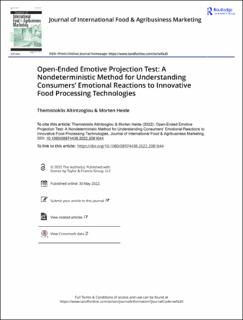| dc.contributor.author | Altintzoglou, Themistoklis | |
| dc.contributor.author | Heide, Morten | |
| dc.date.accessioned | 2022-06-01T08:01:16Z | |
| dc.date.available | 2022-06-01T08:01:16Z | |
| dc.date.created | 2022-05-31T08:43:17Z | |
| dc.date.issued | 2022 | |
| dc.identifier.issn | 0897-4438 | |
| dc.identifier.uri | https://hdl.handle.net/11250/2997150 | |
| dc.description.abstract | The objective of this study was to reveal the efficiency of Open-Ended Emotive Projection Tests (OEEPTs) and Open-Ended Questions (OEQs) in understanding consumers’ reactions to products processed with innovative food processing technologies (IPTs) and the influence of such communication on consumer attitudes, perception of appropriateness and willingness to perform different behaviors. A representative sample of 1206 Norwegian participants were organized in six experimental groups and responded to OEEPTs, an Emotive Projection Test (EPT), OEQs and survey questions. OEEPTs and EPTs showed no significant differences in consumers’ responses between experimental conditions. OEQs indicated that the information on food processed as usual was preferred, while responses to food processed using IPT were not influenced by information about its benefits. This result was confirmed by willingness to try, buy and eat the same products. The main managerial implication is that communicating about benefits should be prioritized over information about IPTs. | |
| dc.description.abstract | Open-Ended Emotive Projection Test: A Nondeterministic Method for Understanding Consumers’ Emotional Reactions to Innovative Food Processing Technologies | |
| dc.language.iso | eng | |
| dc.title | Open-Ended Emotive Projection Test: A Nondeterministic Method for Understanding Consumers’ Emotional Reactions to Innovative Food Processing Technologies | |
| dc.title.alternative | Open-Ended Emotive Projection Test: A Nondeterministic Method for Understanding Consumers’ Emotional Reactions to Innovative Food Processing Technologies | |
| dc.type | Peer reviewed | |
| dc.type | Journal article | |
| dc.description.version | publishedVersion | |
| dc.source.journal | Journal of International Food & Agribusiness Marketing | |
| dc.identifier.doi | 10.1080/08974438.2022.2081644 | |
| dc.identifier.cristin | 2028259 | |
| dc.relation.project | Norges forskningsråd: 281106 | |
| dc.relation.project | Nofima AS: 12307 | |
| cristin.ispublished | true | |
| cristin.fulltext | original | |
| cristin.qualitycode | 1 | |
